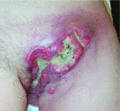Chapter 25: Wound management
Skip chapter table of contents and go to main content


Anatomy and physiology
Malignant fungating wounds are diagnosed based on a histological assessment. A malignant wound can develop from:
- a primary skin tumour such as a malignant melanoma or a squamous cell carcinoma
- an underlying tumour that invades through the surrounding skin structures, such as a breast cancer
- metastases that have spread along tissue planes, capillaries or lymph vessels from a distant primary tumour (Naylor [100]).
Malignant fungating wounds are the result of a cancerous process in which the cells infiltrate and damage the local blood and lymph vessels, which then disrupts the normal flow of blood and lymph, leading to a loss of vascularity and resulting in tissue necrosis (Benbow [15]) (Figure 25.1).
Tumour necrosis and ulceration tend to develop in the centre of the mass as this area is furthest from the surrounding blood supply. Tumours need a blood supply to grow and spread; growth occurs at the periphery of the tumour where the blood supply is rich due to surrounding healthy tissue. The central area of the tumour becomes ischaemic and then necrotizes and ulcerates.
When local invasion of the skin occurs, the initial presentation may be as patches or plaques, which may be inflamed, indurated and hot; the colour can range from deep red to brown/black (Seaman [128]). Lesions can initially present as demarcated nodules, ranging from a few millimetres to several centimetres in size. The areas may be tender to touch, although they are generally painless on initial presentation. The skin may be fixed to underlying tissue with a peau d'orange appearance (swollen pitted skin, resembling orange peel); the skin can then break and ulcerate as the tumour damages further tissues (Wilson [144]). When the lesions extend above the skin surface they may then develop into fungating or ulcerative areas, or a combination of both (Naylor [99]).
Fungating lesions develop through a proliferative process and often have a ‘cauliflower’ appearance (Figure 25.2).

Figure 25.2 Fungating malignant wound from recurrent breast cancer – chest wall resurfaced with flap reconstruction. Recurrent nodules arising around and infiltrating the flap. Source: Naylor ([102]). Reproduced with permission.
An ulcerating lesion has a crater‐like appearance (Naylor [100]), which is undergoing a destructive process through cancer infiltration of the skin and subcutaneous tissues (Alexander [3]) and may have a distinctive ‘lip’ around the edge (Moody and Grocott [96]) (Figure 25.3).

Figure 25.3 Deep ulcerating fungating malignant wound caused by untreated squamous cell carcinoma of the vulva. Source: Naylor ([102]). Reproduced with permission.
The presentation of a malignant wound bed can vary from pale pink to very friable, necrotic or a combination of all three. Malignant lesions are often friable and may bleed easily. The bleeding may occur due to the erosion of local blood vessels or tissue necrosis (Lloyd [80]), or because of impaired platelet function within the tumour (Haisfield‐Wolfe and Rund [59]). The surrounding skin may be fragile, erythematous and tender to touch, with maceration from exudate. As the lesions extend they will produce necrotic areas due to poor vascularization. The necrotic tissue provides an ideal environment for aerobic and anaerobic bacteria to multiply, leading to localized infection with a subsequent increase in exudate and malodour (Benbow [14]). The level of pain experienced by the patient will be dependent on factors such as the depth of tissue invasion, damage to surrounding skin, nerve involvement, location of the wound and the patient's previous experience with pain (Naylor [99]).






